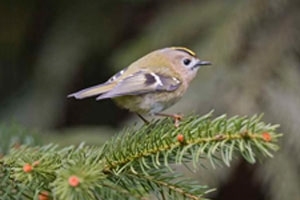Goldcrest (Regulus regulus)
 Harsh winter weather is not a great time to be our smallest British bird - weighing in at only 6 grams and relying completely on a diet of insects - the Goldcrest can suffer huge population crashes in bitterly cold winters. If you discount last winter and the current one, past winters (as opposed to the ones we have experienced in recent decades) were generally much more severe. The famous ornithologist T.A Coward wrote in 1920 following a series of harsh winters, that the Goldcrest “could have little more than an obituary notice” written for it and nearly two hundred years earlier, Hampshire’s Gilbert White wrote that they were “almost as rare as any bird we know”.
Harsh winter weather is not a great time to be our smallest British bird - weighing in at only 6 grams and relying completely on a diet of insects - the Goldcrest can suffer huge population crashes in bitterly cold winters. If you discount last winter and the current one, past winters (as opposed to the ones we have experienced in recent decades) were generally much more severe. The famous ornithologist T.A Coward wrote in 1920 following a series of harsh winters, that the Goldcrest “could have little more than an obituary notice” written for it and nearly two hundred years earlier, Hampshire’s Gilbert White wrote that they were “almost as rare as any bird we know”.
Generally however, winters have been really quite mild over the last 30 years or so and the little Goldcrest has now become a common species, helped too by the extensive planting of its favoured habitat – the conifer. We have not only planted whole forests of conifers, but we also have many coniferous species in our gardens nowadays, bringing this little bird close to our houses. The Goldcrest has a good tactic for bouncing back after severe winter losses – it can lay up 12 eggs in a clutch (though 6-8 is more normal), representing one and half times her own bodyweight! The nest is suspended under a branch of a conifer tree and is made from moss, lichens and spiders' webs, and lined with feathers. The tiny female is incredibly brave and very protective of her nest, sitting tightly on her eggs, reluctant to leave the nest when disturbed.
The Goldcrest has some delightful country names. It is commonly called the Gold-crested Wren because of its small size and orange-yellow head markings. It also has two local Hampshire names – the “Thumb bird” and the “Golden cutty”. The first is perhaps obvious as it is no bigger than your thumb, but the second name is less clear, however I think the word “cutty” in this instance means “cut short” in size.
It also has two lovely local names in Eastern England due to the fact that, believe it or not, our resident population is boosted by birds coming from as far afield as western Russia to spend the winter here. Fishermen in Suffolk referred to the Goldcrest as the "herring spink" or “Tot o’er seas” as many exhausted little flocks would gratefully land on the fishing boats rigging while out in the middle of the North Sea, much to the amazement of these hardy men. Another old English name is the "woodcock pilot", since Goldcrest would often arrive on the eastern coast a couple of days before the migrating Woodcock. Some folk also believed it would be impossible that such a tiny bird could cross the sea and in fact they hitched a ride in the feathers of the larger birds such as owls!
Peter Thompson
Advisory

Download Peter Thompson's essential 26-page book, featuring beautiful photography and detailed profiles of Britain's wildlife
Download FREE >